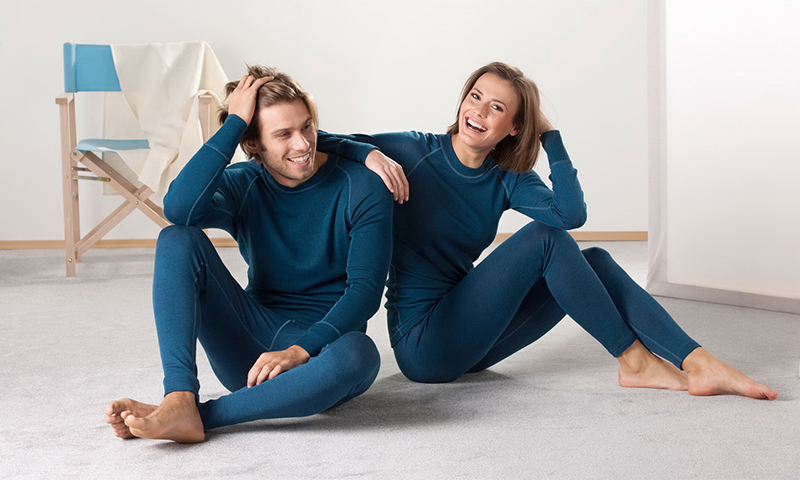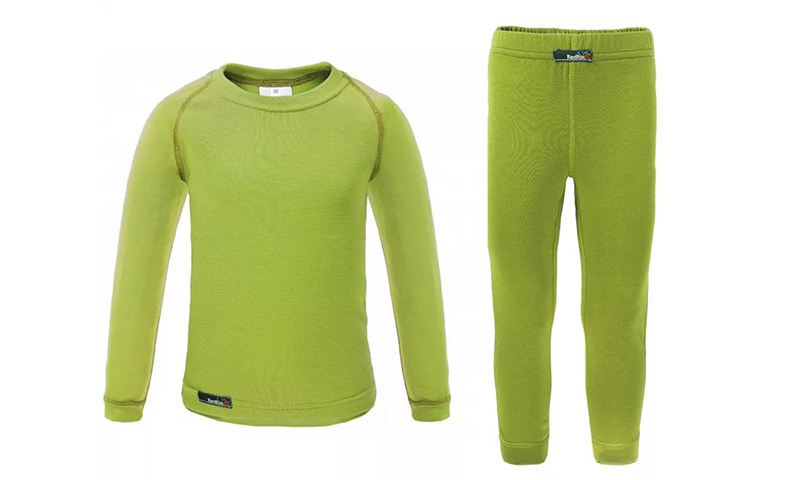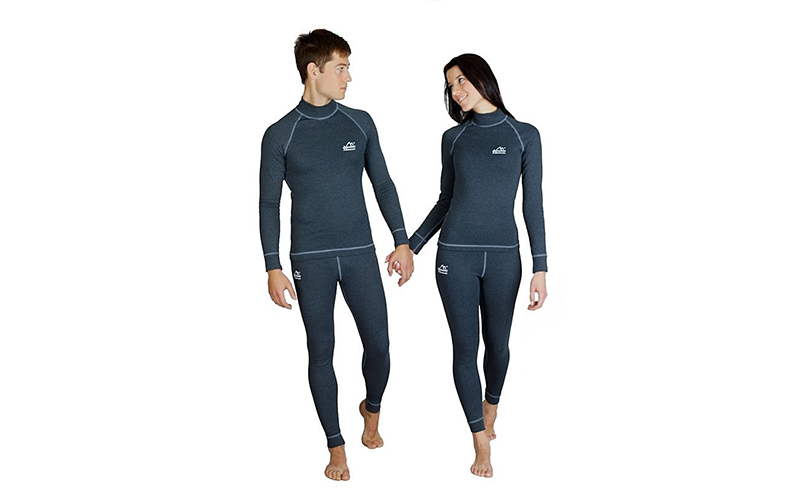Thermal underwear is a great option for those who want to warm up in the winter without turning into a cabbage head. Due to the special weaving of the fabric, it copes well with the preservation of heat and completely replaces 2-3 layers of clothing. However, do not confuse it with a regular coat - thermal underwear “works” quite differently. For those who do not yet know how to choose it correctly, we have prepared detailed instructions that will help find the right set.

Content:
The best manufacturers of thermal underwear - which company to choose
Today, many companies are engaged in the production of thermal underwear. True, some of them simply assign the newfangled name to the most common fleece T-shirts and pants.
In order not to fall for this bait, we recommend to consider only those models that produce sports brands and firms specializing in the production of warm clothing.
Good thermal underwear is in the range of the following companies:
- Norveg;
- Guahoo;
- Craft;
- X-Bionic;
- Red Fox;
- Arcteryx.
Their best models we will consider in ranking, for now let's see how to choose the right thermal underwear for different weather conditions and activities.
Types of thermal underwear
Thermal suits not only retain heat - they also effectively remove moisture from the surface of the body to the outside, because in a wet coat it is easy to freeze even when well dressed. Depending on which of these qualities is more pronounced, thermal underwear and divided into types.
Heat saving (heating)

It is sewn from fabrics with volumetric “wafer” weaving of threads. Due to this, air mini-pockets are formed between the fibers, which reduce heat loss.
The threads themselves also have good insulating properties - as a rule, it is cotton or wool, as well as some artificial materials (microfleece, PE, microplush).
Heat-saving underwear suitable for everyday wear or can be used with low physical exertion.
Pros:
- High level of thermal insulation;
- Due to natural fibers, it is pleasantly felt on the body;
- It warms even at -20 ..- 25 ° С;
- Good density, so from washing such clothes also protects well.
Minuses:
- Insufficient moisture abstraction to the outside and low air permeability of the fabric;
- Shorter durability compared with 100% synthetics.
Wicking (functional)

Such clothes are sewn exclusively from synthetic materials. They do not absorb moisture, but quickly take it outside, leaving the body dry and thereby reducing its heat loss. Here, the fabric thickness is less than in heat-saving things, but vapor permeability is excellent.
The special weaving of fibers in functional linen is different from the heating, although it also has microscopic air pockets. Only here they, when heated, begin to increase in volume, increasing the pressure inside the web. It is under its action that the air literally flies to the outside, along with the smallest particles of sweat.
Pros:
- Higher strength and longer service life compared to natural thermofabric;
- Dries instantly - faster than the body has time to cool;
- When alternating active activities and recreation eliminates the effects of temperature, in other words, sweating in the cold, you do not get sick.
Minuses:
- In such underwear will be warm only if you actively move;
- Wearing pure synthetics is not always comfortable because of its rigidity.
Hybrid

This is a kind of thermal underwear that sweat well and keeps the body warm. For its production they resort to different technologies: they make moisture-removing material more dense or reduce the volume of weaving of fibers in the heat-saving one.However, these half measures give the same mediocre result.
But the most effective is a two-layer underwear, where the moisture-permeable polymer layer is located on the inside, and the space-cellular warm fabric is on the outside.
Pros:
- It is made of blended fabrics, therefore it turns out to be both durable and pleasant to the touch;
- Suitable for active activities at very low temperatures;
- Dense and not blown in the wind.
Minuses:
- Cheap hybrid underwear has very average characteristics - it warms a little, a little moisture wicks. Two-layer and devoid of this shortcoming.
Thermal underwear options

Manufacturing material
This is the most important point when buying thermal underwear. It depends on what fibers were used by the manufacturer for its manufacture, all the properties of a hip depend. Most often it is a blended fabric, but its composition can tell a lot about how the laundry behaves in the winter.
1. Wool
Especially warming effect does not give - too thin a layer of fabric. But its addition to synthetic fibers makes the linen softer and more pleasant. Ideally, if merino wool is used in production, it has natural antibacterial protection and does not absorb moisture, but quickly removes it. Cashmere is excellent, but the price of such clothes will be prohibitive, and it is difficult to care for them.
2. Cotton
It is inexpensive, has a good antistatic effect and is suitable for everyday wear under ordinary clothes, eliminating overheating in the room. It feels nice on the body, but it can hold moisture, so that its presence in the linen for long active activities is undesirable.
3. Polypropylene
Despite its artificial origin, it is considered the best option for the production of thermal underwear, because it does not absorb liquid at all and always remains dry.
4. Polyester
Non-capricious care material also removes excess moisture well, is inexpensive and able to retain heat with moderate activity. Ideal with cotton fibers.
The composition of any thermal fabric can include bacteriostatic or silver-plated yarns that slow down the multiplication of microorganisms in sweat secretions. These include Meryl Skinlife, Odor Resistant, X-Static, and other “patented” fibers. It is thanks to them that thermal underwear, even after a few days, will not smell so much.
Parents also need to take into account that in the composition of children's thermal underwear for the little ones, the presence of a large number of natural fibers is necessary - at least 50-60%. The body of babies under the age of 3 years still does not know how to independently regulate their temperature, so synthetic is contraindicated in its pure form.
Type of physical activity
This is one of the main ways to classify thermal underwear, which is used by manufacturers and sellers. The fact is that for different occupations a podsack must, to a greater or lesser extent, have its main properties - preservation of heat and abstraction of moisture.
Usually in one line you can find costumes for three main types of activity:
1. Minimal - implies sleep or quiet movement on the street at low air temperature. In this state, a person practically does not sweat, which means that instant abstraction of moisture is not required. You can find out the appropriate set by marking Comfort, Soft, Winter, Lifestyle or Cotton.
2. High - this includes all sports and active activities at temperatures below freezing, when a person sweats intensely.
3. Mixed - alternating active activities and recreation. It requires good moisture abstraction, coupled with preserving heat at rest.
In the case of sportswear, the classification becomes even more difficult, branching out “by discipline”:
1. Skiing - requires good hygroscopicity from thermal underwear and at the same time sufficient softness. Therefore, suits are made for skiers with the addition of natural fibers and improved weatherization in the groin area.
2. Figure skating and speed skating - here you need a very thin and dense thermal underwear, perfectly fitting the body, so it may contain elastane.
3. Winter fishing, on the contrary, implies minimal mobility, therefore underwear for fishermen is made warm and dense, with limited moisture permeability. For its manufacture in large quantities using wool.
4. Kayaking, rafting and other water sports allow using only synthetics.
Temperature conditions
Of course, the body of each person reacts differently to the air temperature, so the recommendations of the manufacturers on the label with thermal suits are conditional. But they can be guided by when choosing warm clothes for different seasons. By the way, they wear it not only in winter or autumn, but also in summer - for this purpose, especially light types of synthetic suits are produced.
1. 0 .. + 10 or +10 .. + 20 ° С (can be marked Cool or Outdoor) - a rare type of ultra-thin underwear in our latitudes for playing sports outside. Almost does not heat, but ideally removes moisture, not allowing the body to overcool.
2. +10 ..- 10 ° C (there are also the names Zero Extreme and Thermo Line) - in this it will not be cold outside in the off-season, but not hot when you enter the room.
3. -10 ..- 15 or -5 ..- 25 ° С (Wool Soft or Warm) - this is how the “standard” winter sets are marked, which usually include wool.
4. Below -20 ..- 30 ° С (or Extra Warm) - very dense, often two-layer thermal underwear.
Cut
Manufacturers offer a surprisingly wide selection of thermal underwear. In their assortment there are swimming trunks and shorts, T-shirts and T-shirts, women's bodysuits, as well as children's rompers, tights and even sliders.
It is necessary to choose the cut of such linen in accordance with what parts of the body need thermal insulation the most. It is necessary to take into account the features of outer clothing For example, women prefer to wear tight-fitting things, so they choose elastic underwear of anatomical cut with additional support in the chest area.
For babies, it is better to buy one-piece jumpsuits - in case the outer garment snaps. Also, a child should take a balaclava to protect the head, ears and respiratory organs from frosty air.
For everyday wear, you can choose only one piece of clothing. For example, men in the winter, willy-nilly, have to look for a dressing under pants. And thermocalls will cope with their task best of all. Included with them you can take the shirt, which will remain invisible under the shirt.
The size
Thermal underwear is not just another layer of clothing. It should fit the body tightly, otherwise the desired effect of heat saving cannot be achieved from it. Accordingly, its size must be selected clearly - without a stock.
Each manufacturer has its own dimensional grid, but in general, you can focus on the most common labeling:
1. XXS and XS are children's sizes, corresponding to sizes of 128-134 and 140-146 cm. There is even less laundry, but for it the size is indicated by the child's age.
2. S is “our” 44 size for women and 46-48 for men.
3. M - in women's thermal underwear corresponds to 46-48 sizes, in the men's 48-50.
4. L - for women it is the 50th, for men 50-52.
5. XL - approximately 52-54 sizes for both sexes.
In any case, you should try on a dressing-up before buying - ideally, it should not sag anywhere, otherwise the thermal protection will be incomplete. Keep in mind: this thermal underwear is no different elasticity, so if you decide to take a smaller set, you just can not squeeze into it.
What thermal underwear to choose

1. For everyday wear during the cold season, it is better to take thin or medium density cotton underwear with minimal addition of polymer fibers (especially if you spend part of the day indoors). Preference should be given to heating costumes with little moisture removal.
2. For winter fishing or for sleeping outside, you should also wear a kit designed for low activity. Only it should be thicker, denser and contain more wool. The same applies to the choice of children's thermal underwear.
3. For outdoor activities in cold weather, it is advisable to choose a two-layer or hybrid jumper from blended fibers. The ideal combination would be polypropylene and wool, but if you need to save money, fit polyester with the addition of cotton.
4. On campaigns and on the water (that is, in cases where it is not possible to change into a dry one), the moisture-absorbing, fully synthetic underwear, which does not allow sweating and cold, will show itself well.
5. In the offseason, it is not necessary to put on a deaf set. At not too low temperatures, T-shirts and thermoshorts, as well as any thin costumes made of 100% synthetic, will perfectly cope with the task. They are suitable for intensive sports when it is warm outside but not hot.
Thermal underwear cost

1. Thermal shirt, turtleneck or pants from pure synthetics can be purchased at prices ranging from 700 to 10-11 thousand rubles per item.
2. Cotton female models go from 500 rubles to 12 thousand, men are much cheaper - in the range of 200-6000 rubles.
3. Woolen coats fit in the range of 1-11 thousand rubles, it is more profitable to buy a set of two items - its cost will increase to just 15 thousand.
4. Children's layered clothing can be found at a price of 300-7000 rubles for one item.
It will be interesting to friends too










